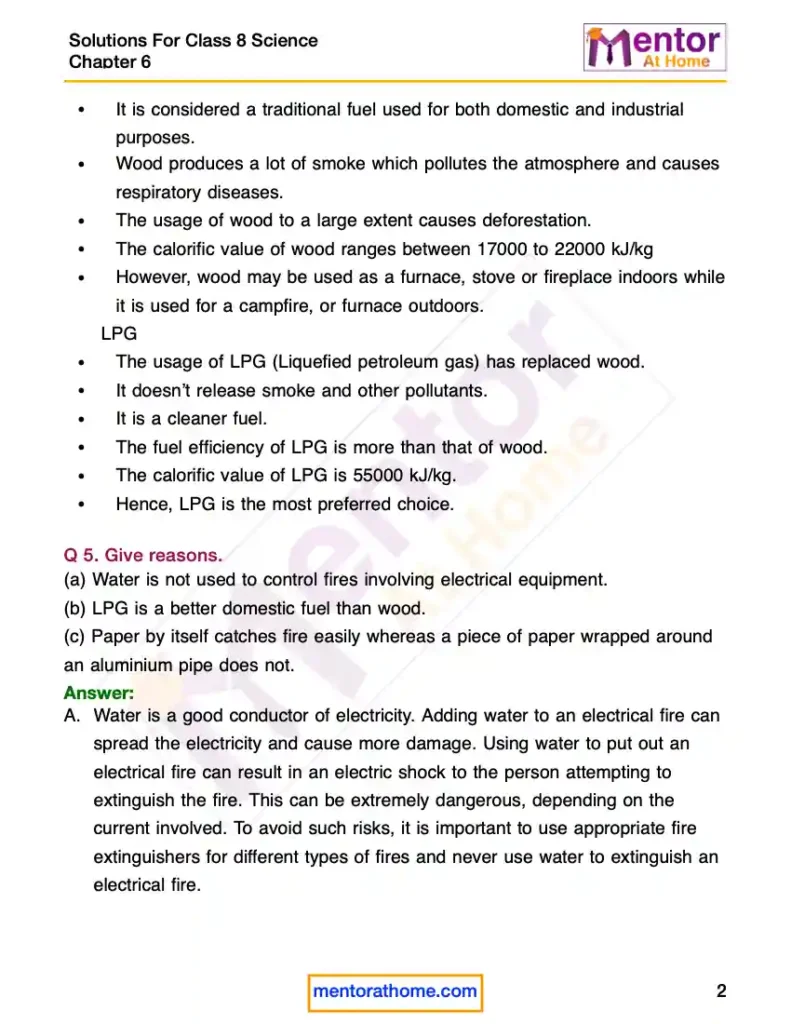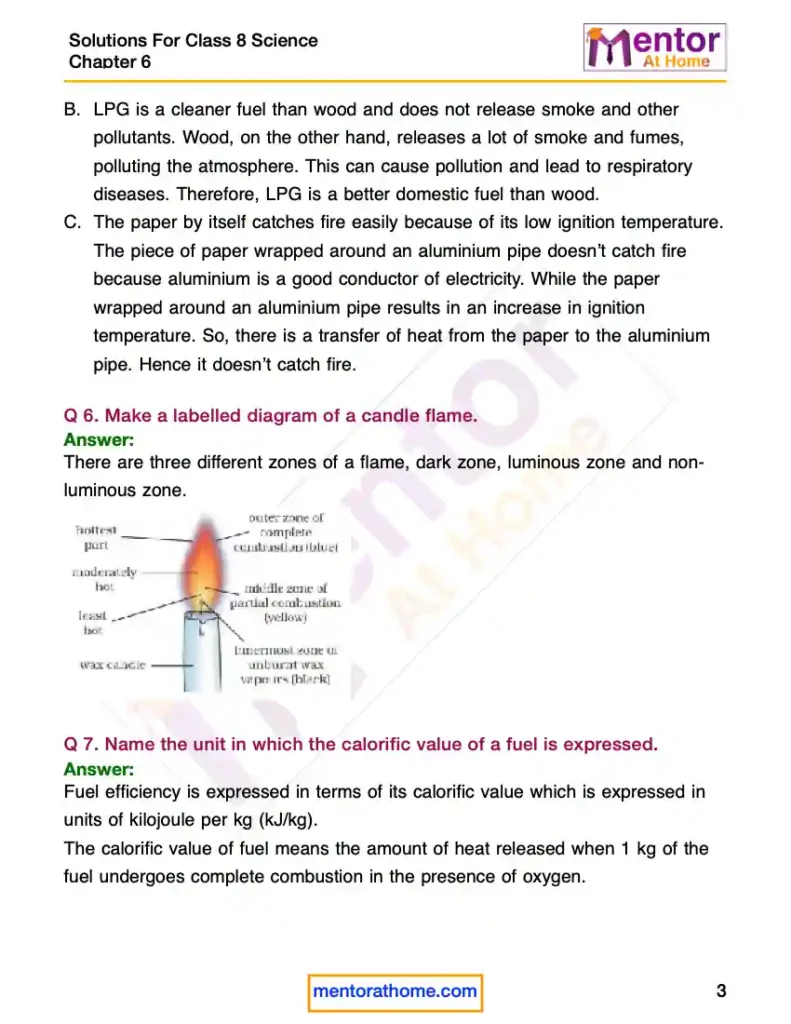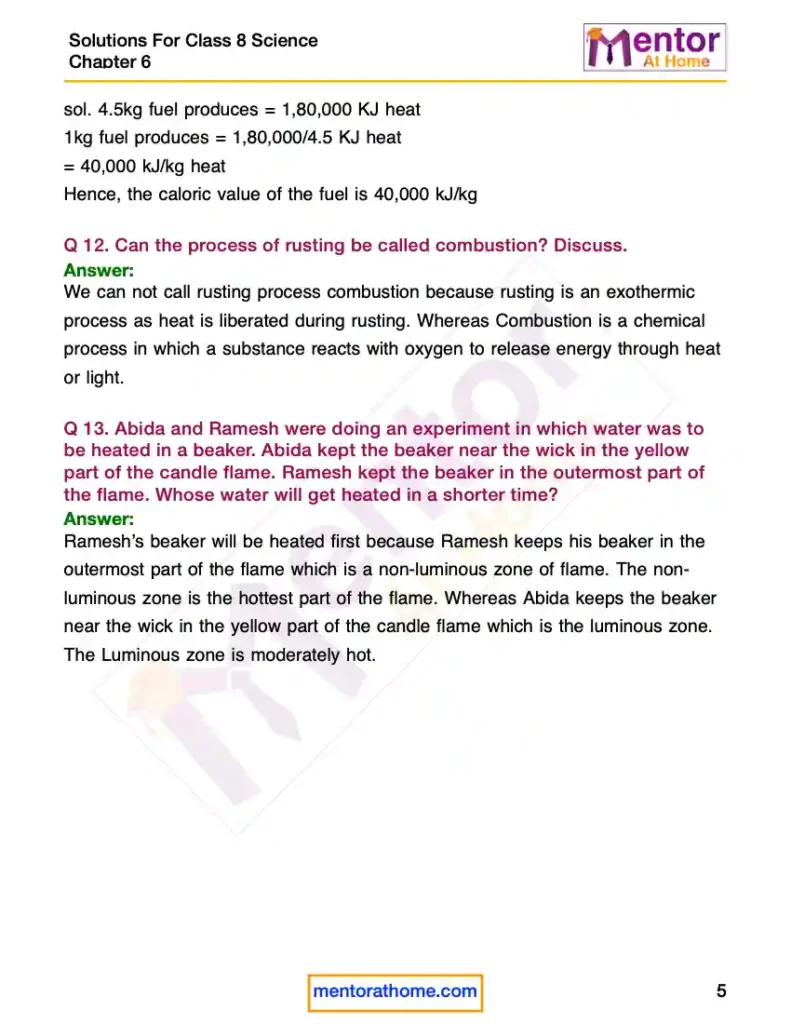NCERT Solutions For Class 8 Science Chapter 6 (2023-24)-Combustion and Flame Solutions Pdf Download
NCERT Solutions For Class 8 Science Chapter 6 Combustion and Flame Solutions deals with Combustion, Types of Combustion, Flame and Zone Of Flame etc. This ncert Class 8th science chapter 6 solution will help you in scoring good marks as they cover important concepts in different patterns like MCQs and short answer questions, worksheets and more. NCERT Solutions Class 8 Science Chapter 6 helps students in many ways. Class 8 Science Chapter 6 Exercises are designed by our subject expert team. Class 8 Science Chapter 6 question answer help in your preparation.
We also provide NCERT Solutions for all classes. You can also check the Class 8 Science Complete Study material.
NCERT Solutions Class 8 Science Chapter 6 Overview
Combustion and Flame Science Chapter 6 Class 8 Solutions cover the topics of Combustion, Types of Combustion, Flame and Zone Of Flame etc.
Class 8 Science Chapter 6 question answer
Class 8th Science Chapter 6 question answer provided below-
Q 1. List conditions under which combustion can take place.
Answer:
The conditions under which combustion can take place are
- Presence of air or oxygen
- Presence of fuel
- Ignition temperature must be reached and maintained
Ignition temperature:– The lowest temperature at which a substance catches fire is called its ignition temperature.
Combustion:- A chemical process in which a substance reacts with oxygen to give off heat is called combustion. During Combustion, fuel gives light off either as a flame or as a glow.
Q 2. Fill in the blanks.
(a) Burning of wood and coal causes __________of air.
(b) A liquid fuel, used in homes is__________.
(c) Fuel must be heated to its ____________ before it starts burning.
(d) The fire produced by oil cannot be controlled by___________.
Answer:
(a) Burning of wood and coal causes Pollution of the air.
(b) A liquid fuel, used in homes is Kerosene.
(c) Fuel must be heated to its Ignition Temperature before it starts burning.
(d) The fire produced by oil cannot be controlled by Water.
Q 3. Explain how the use of CNG in automobiles has reduced pollution in our cities.
Answer:
CNG played an important role in reducing pollution among automobiles for the following reasons
- CNG is a cleaner fuel compared to other fuels like diesel, petrol, and LPG.
- CNG can be used as an alternative to these other fuels in automobiles.
- CNG has fewer undesirable gases compared to the other fuels mentioned above.
- Combustion of fuels like petrol and diesel can result in unburnt carbon particles and carbon monoxide, which can cause respiratory diseases.
Q 4. Compare LPG and wood as fuels
Answer:
Wood
- It is considered a traditional fuel used for both domestic and industrial purposes.
- Wood produces a lot of smoke which pollutes the atmosphere and causes respiratory diseases.
- The usage of wood to a large extent causes deforestation.
- The calorific value of wood ranges between 17000 to 22000 kJ/kg
- However, wood may be used as a furnace, stove or fireplace indoors while it is used for a campfire, or furnace outdoors.
LPG
- The usage of LPG (Liquefied petroleum gas) has replaced wood.
- It doesn’t release smoke and other pollutants.
- It is a cleaner fuel.
- The fuel efficiency of LPG is more than that of wood.
- The calorific value of LPG is 55000 kJ/kg.
- Hence, LPG is the most preferred choice.
Calorific value:– The amount of heat energy produced on complete combustion of 1 kg of a fuel is called its calorific value. The calorific value of a fuel is expressed in a unit called kilojoule per kg (kJ/kg).
Q 5. Give reasons.
(a) Water is not used to control fires involving electrical equipment.
(b) LPG is a better domestic fuel than wood.
(c) Paper by itself catches fire easily whereas a piece of paper wrapped around an aluminium pipe does not.
Answer:
a)
- Water is a good conductor of electricity.
- Adding water to an electrical fire can spread the electricity and cause more damage.
- Using water to put out an electrical fire can result in an electric shock to the person attempting to extinguish the fire.
- This can be extremely dangerous, depending on the current involved.
- To avoid such risks, it is important to use appropriate fire extinguishers for different types of fires and never use water to extinguish an electrical fire.
b)
- LPG is a cleaner fuel than wood and does not release smoke and other pollutants.
- Wood, on the other hand, releases a lot of smoke and fumes, polluting the atmosphere.
- This can cause pollution and lead to respiratory diseases.
- Therefore, LPG is a better domestic fuel than wood.
c)
- The paper by itself catches fire easily because of its low ignition temperature.
- The piece of paper wrapped around an aluminium pipe doesn’t catch fire because aluminium is a good conductor of electricity.
- While the paper wrapped around an aluminium pipe results in an increase in ignition temperature. So, there is a transfer of heat from the paper to the aluminium pipe. Hence it doesn’t catch fire.
Ignition temperature:- The lowest temperature at which a substance catches fire is called its ignition temperature.
Q 6. Make a labelled diagram of a candle flame.
Answer:
There are three different zones of a flame, dark zone, luminous zone and non-luminous zone.

Dark zone:- It contains vapours of fuel and unburnt carbon particles that is black in colour and the least hot part of the flame.
luminous zone:- The middle zone of particle combustion that is yellow in colour and produces light.
Non-luminous zone:- It is the outer zone of flame, which is faintly blue in colour and the hottest part undergoes complete combustion of the substance.
Q 7. Name the unit in which the calorific value of a fuel is expressed.
Answer:
Fuel efficiency is expressed in terms of its calorific value which is expressed in units of kilojoule per kg (kJ/kg).
The calorific value of fuel means the amount of heat released when 1 kg of the fuel undergoes complete combustion in the presence of oxygen.
Q 8. Explain how CO2 is able to control fires.
Answer:
CO2 is a non-combustible gas that can extinguish a fire because
- CO2 is heavier than oxygen It covers the fire like a blanket and cuts off the contact between oxygen and fuel due to lack of oxygen fire is extinguished.
- In cylinders, CO2 is kept in liquid form. When released, it expands enormously. This brings down the temperature of the fuel, which helps in controlling the fire.
Q 9. It is difficult to burn a heap of green leaves but dry leaves catch fire easily. Explain.
Answer:
A heap of green leaves contains a lot of moisture in it, hence its ignition temperature is high. Therefore, it does not catch fire easily.
But dry leaves have no moisture content in them, hence their ignition temperature is low. Therefore, it catches fire easily.
Ignition temperature:- The lowest temperature at which a substance catches fire is called its ignition temperature.
Q 10. Which zone of a flame does a goldsmith use for melting gold and silver and why?
Answer:
The goldsmith mainly uses non-luminous zone flame which is the outermost part of the flame. This part of the flame is used because the outermost flame undergoes complete combustion and is the hottest part of the flame.
Non-luminous zone of Flame:- It is the outer zone of flame, which is faintly blue and the hottest part.
Q 11. In an experiment, 4.5 kg of fuel was completely burnt. The heat produced was measured to be 180,000 kJ. Calculate the calorific value of the fuel.
Answer:
The calorific value of fuel means the amount of heat released when 1 kg of the fuel undergoes complete combustion in the presence of oxygen.
Given: 4.5kg fuel produces heat 1,80,000 KJ
Find ?: Its caloric value of the fuel in kJ/kg
sol. 4.5kg fuel produces = 1,80,000 KJ heat
1kg fuel produces = 1,80,000/4.5 KJ heat
= 40,000 kJ/kg heat
Hence, the caloric value of the fuel is 40,000 kJ/kg
Q 12. Can the process of rusting be called combustion? Discuss.
Answer:
We can not call rusting process combustion because rusting is an exothermic process as heat is liberated during rusting. Whereas Combustion is a chemical process in which a substance reacts with oxygen to release energy through heat or light.
Q 13. Abida and Ramesh were doing an experiment in which water was to be heated in a beaker. Abida kept the beaker near the wick in the yellow part of the candle flame. Ramesh kept the beaker in the outermost part of the flame. Whose water will get heated in a shorter time?
Answer:
Ramesh’s beaker will be heated first because Ramesh keeps his beaker in the outermost part of the flame which is a non-luminous zone of flame. The non-luminous zone is the hottest part of the flame. Whereas Abida keeps the beaker near the wick in the yellow part of the candle flame which is the luminous zone. The Luminous zone is moderately hot.
Luminous zone:- The middle zone of particle combustion that is yellow in colour and the Luminous zone is moderately hot.
Non-luminous zone:- It is the outer zone of flame, which is faintly blue in colour and the hottest part undergoes complete combustion of the substance.
Class 8 Science Chapter 6 Question and Answer Pdf
Class 8 Science Chapter 6 Keywords Solutions
Class 8 Chapter 6 Science Keywords Definition
- Combustion: Combustion is defined as the chemical process in which substances with oxygen take place to give off light and heat. E.g., burning wood
- Acid rain:- When pollutants like sulphur dioxide and nitrogen oxide dissolve in rainwater. it forms an acid. The rain of that acid is called acid rain.
- Calorific value:- means the amount of heat released when 1 kg of the fuel undergoes complete combustion in the presence of oxygen. which is expressed in units of kilojoule per kg (kJ/kg).
- Deforestation:-
- Explosion:- The process of combustion in which a large number of gases are evolved with the production of a tremendous amount of heat, light and sound is called an explosion.
- Flame:- The visible part of the fire, which contains gases, is called flame. Some substances vapourise during burning and give flames. For example, kerosene oil and molten wax.
- Fire Extinguisher:- The non-combustible substance that can extinguish a fire. For example, CO2 is Fire Extinguisher gas.
- Fuel:- The substance which is used for burning for various purposes like cooking.
- FuelEfficiency:- Fuel efficiency is expressed in terms of its calorific value which is expressed in units of kilojoule per kg. The higher the calorific value, is good efficient the fuel and vice versa.
- Global warming:- Global warming is the phenomenon of a gradual increase in the average temperature of the earth.
- Ideal Fuel:- Which produces a large amount of heat. It does not leave behind any undesirable substances. It burns easily in the air at a moderate rate and is cheap.
- Ignition temperature:- is the lowest temperature at which a combustible substance catches fire.
- Inflammable substances:- The substances which have very low ignition temperatures and can easily catch fire with a flame are called inflammable substances. Examples of inflammable substances are petrol, alcohol, Liquified Petroleum Gas (LPG) etc.
Class 8th Science Chapter 6 Extra Question
NCERT Solutions For Class 8 Science Chapter 6 Extra Question
NCERT Solutions For Class 8 Science Chapter 6 MCQ
NCERT Solutions Class 8 Science Chapter 6 MCQ
We hope you like the NCERT Solutions For Class 8 Science Chapter 6 –Combustion and Flame Class 8 Solutions. NCERT Solutions For Class 8 Science Chapter 6 help in your preparation. If you like ncert Class 8th science chapter 6 solution then please share this post with your friend and classmate.
Here our aim is to help students by providing study material. We provide all NCERT books from Class 8 to Class 8th and here you also find notes and solutions from Class 8 to 12th for this go-to link. You can also download Class 8 Science Chapter 6 Notes pdf.




